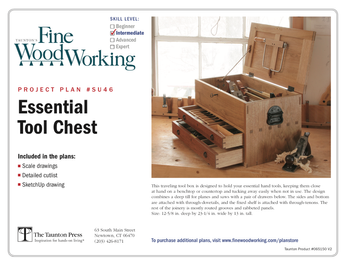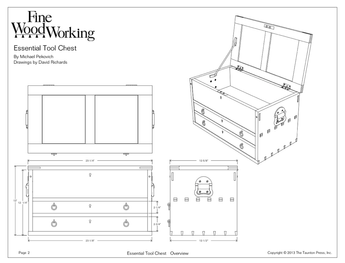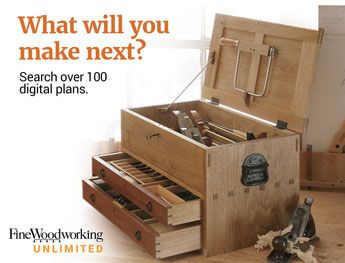I’m building a desk using walnut. The top is 1” thick and 26”deep and 56”wide. It was nice and flat after glue up and milling with a flattening jig. Shellac and lacquer for the finish and noticed when I went to mount the top it had bowed really bad across the depth. I don’t recall the moisture content of the wood but was in the low teens. My shop humidity ranges from 15-25%. Even a sheet of plywood brought in to my shop will warp/bow. Is humidity the issue?
Discussion Forum
Get It All!
UNLIMITED Membership is like taking a master class in woodworking for less than $10 a month.
Start Your Free TrialCategories
Discussion Forum
Digital Plans Library
Member exclusive! – Plans for everyone – from beginners to experts – right at your fingertips.
Highlights
-
Shape Your Skills
when you sign up for our emails
This site is protected by reCAPTCHA and the Google Privacy Policy and Terms of Service apply. -
 Shop Talk Live Podcast
Shop Talk Live Podcast -
 Our favorite articles and videos
Our favorite articles and videos -
E-Learning Courses from Fine Woodworking
-
-












Replies
I've countered this by running a kerf lengthwise down the top. In 1" I'd shoot for 7/8" stopping an inch or so from either end.
I built a "floating" desk for a client years ago, it cupped pretty bad. So I brought my track saw to the site before move in and ran 3 kerfs down the length. It flattened back out when refastened to its ledgers and I haven't heard anything about it.
Did you remove material from both sides or just one? When milling, I try to be equitable, so flip the board often unless its just a pass or two.
More often than not, I rely more on the mounting system to keep things flat. 1" walnut shouldn't be too hard to flatten with mounting hardware.
Good luck
Thank you for the tip. I hadn't thought about running a kerf down the length but it makes sense. I did mill it equal on both sides.
Is it bowed, or cupped? Your description sounds like cupped. Bowed is along the boards' long direction, cupped across the short. Is it a glued up top?
It is cupped and bowed. The bow is minimal and will probably correct when I mount the top but the cup is bad. It is a glue up of 4 boards.
Did you apply finish on both sides of the top?
Yes, it is finished on both sides.
Do you have the option to flip the top so the concave side is down? With the cup down all of the fasteners can contribute more to holding it flat.
I don't have the option to flip the top.
The desk I have built is based on using figure 8's to mount the top. I'll have to look at the effort required to push flat when I get back to the shop tomorrow. Part of me is leaning towards c-channel just to gain some experience from that process if I ever graduate to a bigger table project.
If you are going to add metal you are back to using fasteners to hold the top flat and compromising the top further by (possibly?) cutting channels. The amount of cup and bow seems minimal and solvable.... perhaps wood battens can be worked in somewhere?
We have no idea what your design is so this is all speculation and guesswork on getting a panel flat with no real relationship to the desk you are building.
I suppose a wood batten in the center would be a viable option.
Wood does stuff. What was the time interval between when you joined up the top and when you went to use it? I have, but don't like to, constructed parts for future or long drawn out projects. The possibility of something happening or changing increases with time or environmental changes ,like weather.
That your top cupped like that is not surprising and not for any particular reason. In the course of making many things one comes to realize that sometimes things just happen. "I made them all the same and they all came out fine- except that one!" But you seem to be having a bigger problem. You claim that your shop humidity range is 15 to 25%. That's 24/7? Humidity is relative to temperature- how do you maintain that? Are you in Palm Springs because that is astonishingly low. Right now,because I just looked it up, Death Valley is at 40% relative humidity- but its night, earlier in the day the second driest place on earth was 20%. I struggle to maintain about 35% in my shop and fail often and live in what many refer to as a Mediterranean climate. If besides your top warping you also have plywood warping simply from being in your shop then somehow I would think that however your determining your humidity your off somehow. I have both a digital and an old analog hydrometer in my shop and they almost never completely agree. The accuracy of not very expensive hydrometers is questionable. I installed in my shop once one of those Mr Heat infrared propane heaters. Toasty warm, raise the temperature lowers the humidity ,right? Wrong! The humidity went sky high! Turns out that a by product of burning propane is water vapor. You say your humidity is very low and then ask the question- could your problem be humidity? Could be!
I'm in Tennessee. My shop air is conditioned with mini-split units. I keep the temperature between 68-70, 24/7. I have a digital and analog hydrometer and they never read the same either. I don't recall what the humidity level is during the summer months. I do know that I have a dehumidifier that cycles during the spring/summer/fall. Seems like it is set around 35% and runs constantly.
Hi! Here's a great article that can explain this - Anything related to moisture measurement and EMC -
https://www.wagnermeters.com/video-library/equilibrium-moisture-content-what-is-it-emc/
Yes, humidity is likely the culprit. A 15-25% humidity level is quite low, which can cause wood to dry out and warp. Walnut, like most hardwoods, moves with moisture changes. Try storing your wood in the shop environment for a longer period before milling and consider sealing both sides equally to minimize future warping.
Thank you
Wood destined for large panels sits in the house for at least a month, and the glued-up panel comes back into house with the glue still wet, clamps on.
You should consider building two or three battens into the top of the desks frame. A kerf or two cut into the bottom would ease out the tension in the panel. I would not glue the battens but fasten them so enough movement is resulting across the top.
Breadboard ends. Simple.
Lol, you asked for it. As you can see, it is much easier to answer a question, than find an answer for a question.
My .02, don’t waste your time with c channel unless its something you really wanna incorporate in your work. Wood battens would be hidden within the design and should do the trick if adding anything is even necessary.
First thing that should’ve been asked, have you tried clamping the top down and securing it to see if the cup goes away?
I did ask for it 😀. I’m convinced battens would work but I’m going to go the c-channel route, only to learn a new technique for a future project. I did not clamp it down to try that. That would have been easy to do 🤦
It is one cup and is about 3/16 on one end and 1/8 on the other. I would think a c-channel would work. Do you think that is too much bow across 26" for the c-channel to work. I suppose maybe a combination of that along with a length wise kerf?
I personally don't think I would do anything much for a cup that small over 26". I would probably put a couple of extra top fasteners close to the middle of the span, if it's the center that's raised, but that should be enough. I assume you can push it flat without a lot of effort. If so, the fasteners should do the job. Let us know what you do and how it goes!